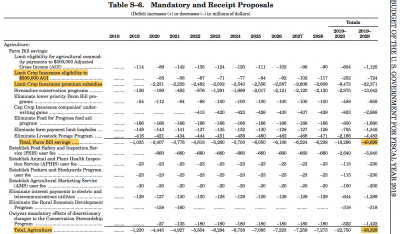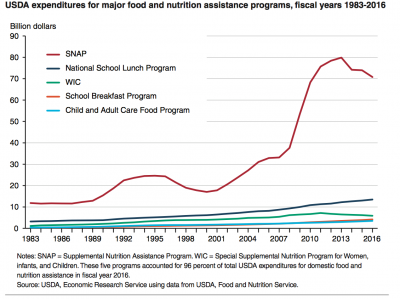As 2026 ushers in a fresh start, agricultural economists say the U.S. farm economy has stopped sliding, but it’s far from fully healed.The December Ag Economists’ Monthly Monitor shows month-to-month…
In Budget Proposal, White House Seeks Cuts To Crop Insurance and SNAP
On Monday, the Trump administration released its budget proposal for fiscal year 2019. Like last year, the budget outline contained proposed cuts to crop insurance and the SNAP program. Today’s update looks at these budget ideas in greater detail.
Background
In May of 2017, the Trump administration released its first budget blueprint (for fiscal year 2018) which contained proposed cuts to crop insurance and the Supplemental Nutrition Assistance Program (SNAP).
Secretary of Agriculture Sonny Perdue appeared before the House Appropriations Subcommittee on Agriculture a couple of days later where lawmakers quizzed the then newly sworn in USDA chief in more detail about the President’s proposals. And in June, Sec. Perdue provided testimony on the budget to the Senate Appropriations Subcommittee on Agriculture.
On Monday, the executive branch made public its budget outline for fiscal year 2019. Like last year, the document contained proposed cuts to both crop insurance and SNAP.
Trump Budget Outline- Crop Insurance
Specifically, the budget document indicated that, “The Budget proposes to optimize and improve crop insurance and commodity programs in a way that maintains a strong safety net.
The Budget does this while also achieving savings, eliminating subsidies to higher income farmers, and reducing overly generous crop insurance premium subsidies to farmers and payments made to private sector insurance companies.
“The Budget includes a bold set of proposals, including those that would reduce the average premium subsidy for crop insurance from 62 percent to 48 percent and limit commodity, conservation, and crop insurance subsidies to those producers that have an Adjusted Gross Income of $500,000 or less.”

DTN Ag Policy Editor Chris Clayton reported on Monday that, “Farmers would pay a larger share of crop-insurance premiums and a range of ag industries would have to pony up fees for USDA services under the Trump administration’s latest budget proposal released Monday.
“The White House proposed budget for Fiscal Year 2019 includes 10-year farm-bill cuts of $47 billion for farmer programs.”
Mr. Clayton added that, “The Trump administration budget proposal recommends several legislative changes to farm programs, making it timely as Congress drafts a new farm bill this year. The major cuts that would affect farmers are proposals to cap crop insurance premium subsidies, which would reduce federal spending on insurance by roughly $22.4 billion over 10 years. Cuts to conservation programs would reduce spending $13 billion over 10 years.”
Roberts told the Kansas Ag Summit last year that during a White House meeting on crop insurance in June, Trump dialed his top budget official, Mick Mulvaney, and told him he wouldn’t cut the program. Today his budget proposes cuts to the program. https://t.co/Tw27YYMfyG
— Lindsay Wise (@lindsaywise) February 12, 2018
Meanwhile, Jonathan Shorman and Lindsay Wise reported on Monday at The Wichita Eagle Online that, “Kansas Sen. Pat Roberts said President Donald Trump made a commitment to him in the Oval Office last year not to cut crop insurance, a key program for farmers.
“Trump’s budget proposal cuts the program anyway.”
Shorman and Wise explained that, “The proposed cuts come after Roberts — concerned about reductions proposed in Trump’s budget last year — sought a promise from the president that he would protect crop insurance during a conversation at the White House in June.
“The Republican chairman of the Senate Agriculture Committee said after the meeting last year that he felt had been able to convince the president that crop insurance was a ‘very valuable and needed program.’
He recalled that Trump called his top budget official, Mick Mulvaney, on the phone and, after some discussion, told Mulvaney he wouldn’t cut crop insurance.
Nonetheless, the article noted that, “Roberts said he was glad to have had the opportunity to discuss crop insurance with Trump last year, and believes the president is committed to rural America.
“‘I will hold him at his word and look forward to sending him a Farm Bill with a Crop Insurance program that protects farmers and ranchers and ensures our country has a safe and affordable food supply,’ Roberts said in a statement.”
.@ConawayTX11 & @SenPatRoberts react to the President’s FY19 budget proposal: https://t.co/KDepnGss8s @SenateAgGOP pic.twitter.com/nI5rKBnczn
— House Ag Committee (@HouseAgNews) February 12, 2018
Trump Budget Outline- SNAP
Bloomberg writer Alan Bjerga reported on Monday that, “In what would be one of the biggest shakeups of the U.S. food-stamp program in its five-decade history, President Donald Trump is proposing to slash cash payments and substitute them with ‘100 percent American grown food’ given to recipients.
“The changes, outlined Monday in Trump’s budget proposal, would reshape the Supplemental Nutrition Assistance Program, or SNAP, which supports roughly one in eight Americans, by reducing cash spending by about one-third from current levels.”
Mr. Bjerga added that,
The plan is part of an effort to reform SNAP and save a projected $214 billion over a decade. It would give all households receiving more than $90 a month in cash a food-aid package that would ‘include items such as shelf-stable milk, ready to eat cereals, pasta, peanut butter, beans and canned fruit, vegetables, and meat, poultry or fish,’ according to the proposal.
The Bloomberg article explained that, “Under the plan, the amount of food a household receives would be scaled to the size of the allotment, with about half of the assistance coming as food instead of cash. The USDA already buys commodities for other programs, such as the National School Lunch Program, and states would largely be in charge of distribution, the department said.
“‘States can distribute these boxes through existing infrastructure, partnerships, and/or directly to residences through commercial and/or retail delivery services,’ the department said in a statement.”

A National Public Radio article from Monday pointed out that, “Critics of the proposal said distributing that much food presents a logistical nightmare. ‘Among the problems, it’s going to be costly and take money out of the [SNAP] program from the administrative side. It’s going to stigmatize people when they have to go to certain places to pick up benefits,’ says Jim Weill, president of the nonprofit Food Research and Action Center.”
Hard to imagine how this would work. Government agencies would have to buy and distribute billions of dollars of food to millions of people -- and do it more cheaply than Walmart. https://t.co/h16OA8kdgU
— Dan Charles (@nprDanCharles) February 12, 2018
Also with respect to SNAP and the executive branch outline, Washington Post writers Tracy Jan, Caitlin Dewey and Jeff Stein reported on Monday that, “The proposal repeats several cost-cutting measures from last year, including new restrictions on eligibility and stricter requirements around the use of work-requirement waivers, which allow states with high unemployment rates to extend benefits to adults who are out of work for longer than three months.
“Congress has final say over spending — but Monday’s budget proposal is seen as an important sign of Trump’s priorities.”





